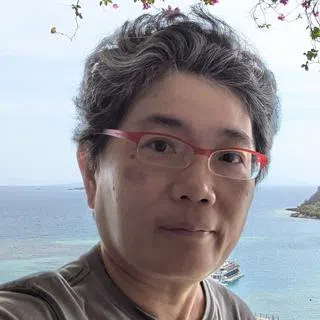[Photos] From the balcony: A writer’s love letter to Xiamen

In the seaside city of Xiamen, old and new — as well as Eastern, Western and Southeast Asian influences — coexist seamlessly. This coexistence manifests itself in Xiamen’s unique cuisine, culture and architecture, says writer Ng Kong Ling, who tells us more about what the vibrant city has to offer.
(Photos: Ng Kong Ling)
As I step onto the balcony of the Lujiang Hotel in Xiamen, China, I am struck by the city’s rich essence. Across the water, Gulangyu Island unfolds like a long scroll painting; on the Lujiang River, boats come and go with horns sounding. In front of the hotel is Lujiang Road, bustling with crowds and traffic, and with life in full swing.
The balcony perches over the street, and standing on it makes me feel like I am smack in the middle of the road. I cannot stop taking photos. They may not be able to capture the noise of the city, the smell of the harbour, or the temperature and humidity in the air, but it does immortalise the iconic view of Gulangyu.
To me, this spot is as “Xiamen” as it gets. No matter the time of day, I want to step out and take another look. Dawn and dusk, day and night, the scenes are all different. The sounds of the street never cease, punctuated only by the chimes of the Customs House clock tower, which plays the beautiful melody of Waves of Gulangyu (鼓浪屿之波) four times a day.
Instead, some roads curve gently, while alleys and main streets vary in width and branch off unpredictably. It is easy to lose your way here.
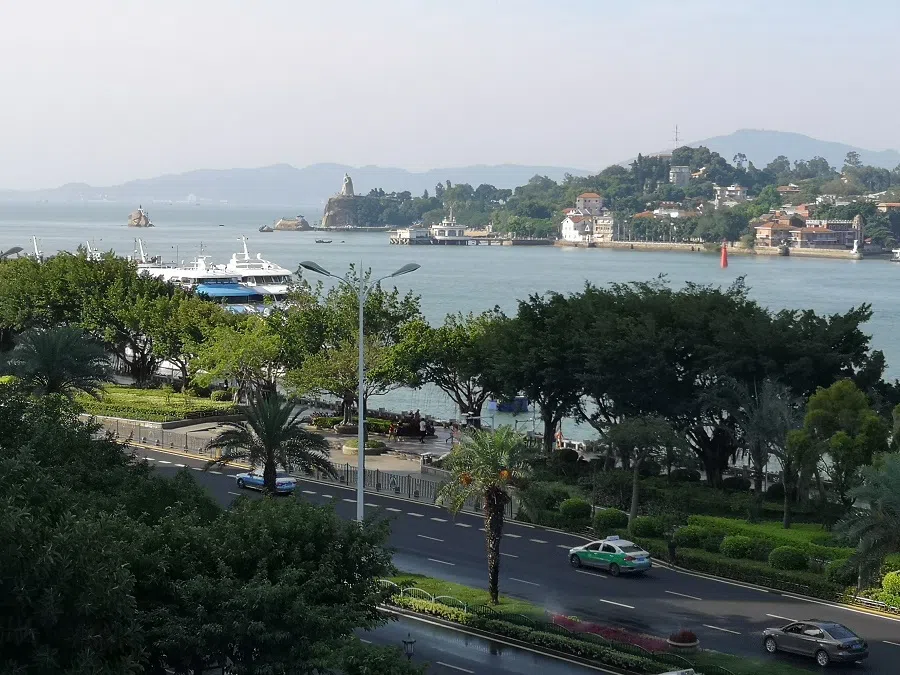
Xiamen has changed a lot and made tremendous progress over the years. A quick internet search reveals plenty of new hotspots full of artistic and boutique charm. Beyond the old town, other districts boast an even more modern and vibrant cityscape, with luxury hotels and shopping malls. The metro system is modern and convenient, and the transportation network is extensive. Exploring Xiamen is not limited to the island itself — there is a wider world beyond that.
Given my fondness for old Xiamen, I searched through all available information, only to find myself going back to where it all started for me.
Starting from the sea
Despite the city’s developments and changing times, the Lujiang Road and Zhongshan Road areas remain the best entry point to experiencing Xiamen.
Since ancient times, Xiamen has been a gateway to the sea. After the First Opium War, it became one of the five treaty ports. In the 1930s, a large-scale urban development movement took place, and many overseas Chinese contributing funds and efforts to its construction. This gave the old town a unique blend of Chinese and Western influences, infused with a touch of Southeast Asian charm.
Traditionally, Xiamen’s old town starts at the ferry terminal and stretches across several blocks, covering Siming South Road, North Road, West Road and East Road. Most of the road network and buildings in this area have retained their layout from the last century. As you walk through the streets today, you will notice that the city’s roads are not built in the same grid-like layout in many modern cities. Instead, some roads curve gently, while alleys and main streets vary in width and branch off unpredictably. It is easy to lose your way here.
Since it opened, Zhongshan Road has been Xiamen’s most important commercial street.
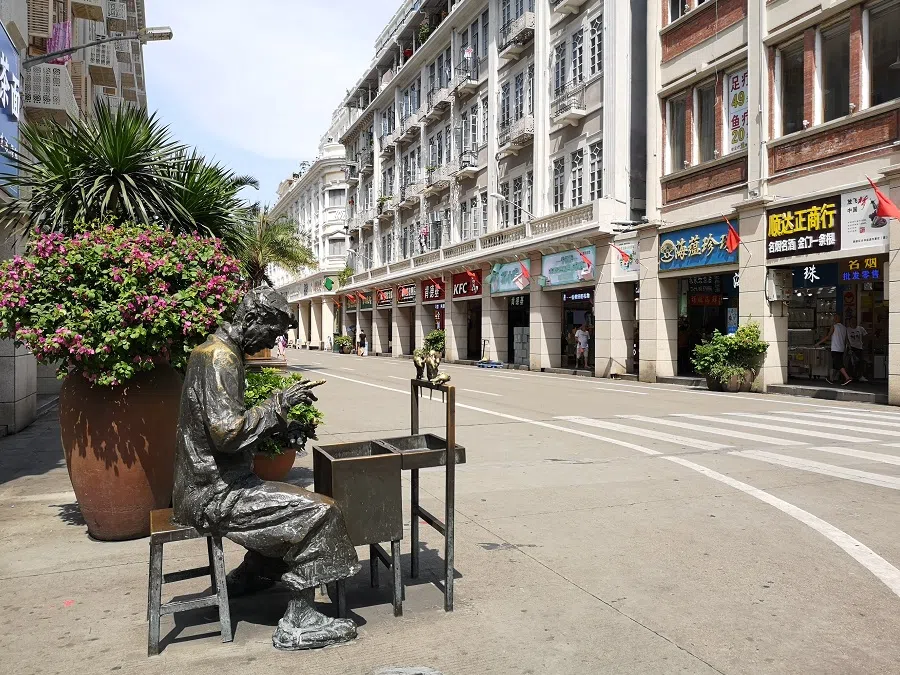
The best method for navigation is to use Zhongshan Road as your reference point. This pedestrian street is closed to vehicular traffic, making it highly recognisable. You can wander freely along the side streets, and if you get lost you can simply return to Zhongshan Road. Walking from one end to the other takes you through the heart of the old district, offering a glimpse into the charm of old Xiamen with no map required.
Since it opened, Zhongshan Road has been Xiamen’s most important commercial street. In 2006, it was transformed into a pedestrian street, making it one of the best-preserved and most vibrant historic districts in the city.
Old buildings with overseas Chinese influence
Many cities in China have pedestrian streets, but Xiamen’s Zhongshan Road is unique as it is the only one that leads directly to the sea. The street’s entrance faces the ocean, with Gulangyu Island in the distance across the water. The intersection of Zhongshan Road and Lujiang Road, commonly known as “Haikou” (lit. “sea mouth”, entrance to the sea), is marked by one of Xiamen’s most iconic landmarks — the Lujiang Hotel, originally built in 1958.
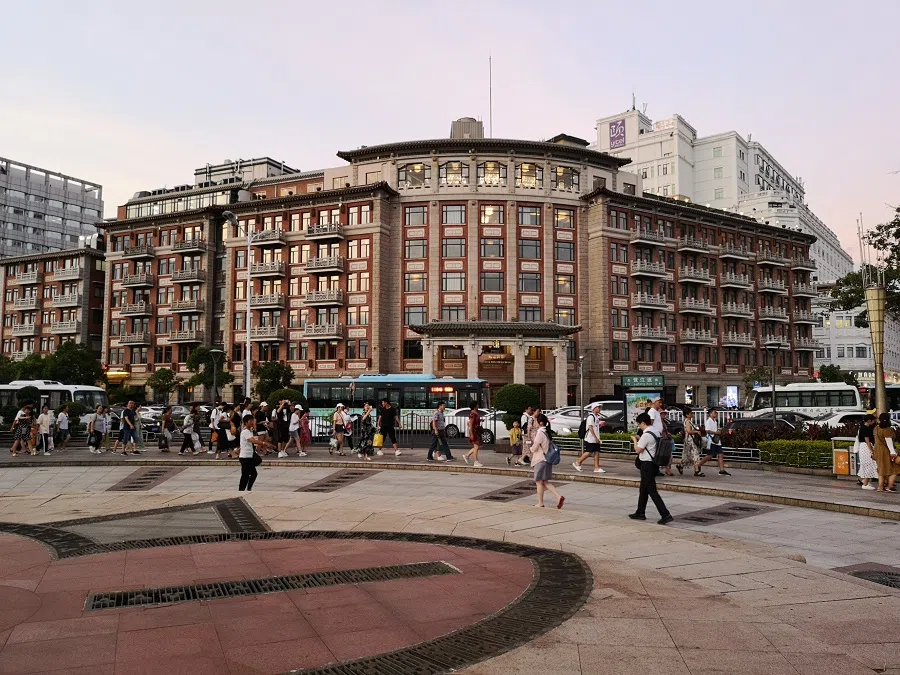
The old building is a classic example of the Jiageng (嘉庚) architectural style, named after businessman and philanthropist Tan Kah Kee (陈嘉庚), who originally proposed its construction. The seven-story building blends Chinese and Western influences, featuring red brick walls and green-tiled roofs. Once Xiamen’s tallest building, it housed the city’s first elevator, bar, and nightclub. Despite its historical significance, Lujiang Hotel remains reasonably priced, unlike other similar hotels with the same air of luxury. It retains a modest, welcoming charm, embodying the down-to-earth spirit of the overseas Chinese who helped shape Xiamen.
Nowadays, the term hua qiao (华侨 overseas Chinese) is rarely used outside of China. Exceptions include its use in Xiamen, or when referring to OCBC (Oversea-Chinese Banking Corporation). From certain angles in the hotel, you can see the bank, with its familiar letters on an old Nanyang-style building. For a moment, it feels like I have been transported back to Singapore.
OCBC opened a Xiamen branch in 1925, and moved into this building in 1947. Standing at the street corner for over 50 years, the bank has witnessed Xiamen’s changes. A few years ago, it was reconstructed in its original style, preserving its distinctive Nanyang shophouse style. This location was once a key remittance centre for overseas Chinese sending money home.
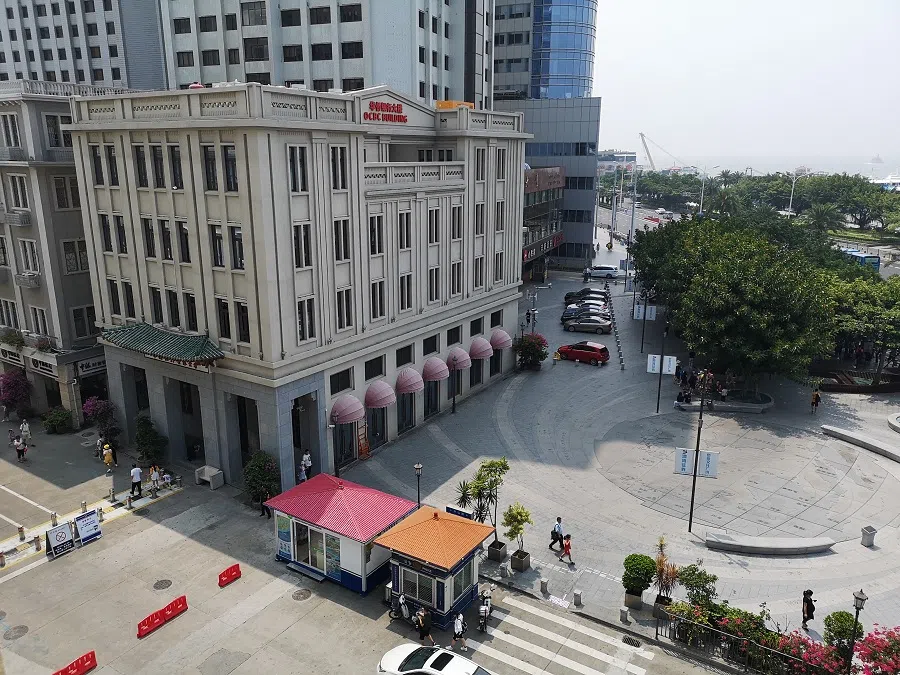
In front of the building now is Qiaopi Cultural Square. By way of remembrance, the stone tiles on the ground are engraved with the cities and addresses of over a hundred remittance agencies that once operated nearby.
The bank and hotel — steeped in the flavour of overseas Chinese — stand guard on either side of Zhongshan Road’s entrance, making them ideal gateways to exploring the Zhongshan pedestrian street and the old Xiamen district.
The buildings lining the street have retained their historic facades, but they pulse with youthful energy inside.
Old district, new look
Stepping from the nostalgic Haikou onto Zhongshan Road, I am greeted by a bustling pedestrian street teeming with people. Once a congested thoroughfare, its transformation into a car-free walkway has made it feel more spacious and grand. The buildings lining the street have retained their historic facades, but they pulse with youthful energy inside. The old storefronts have been given a fresh look — traditional businesses have been replaced by trendy shops, all meticulously restored with a vibrant new sheen.
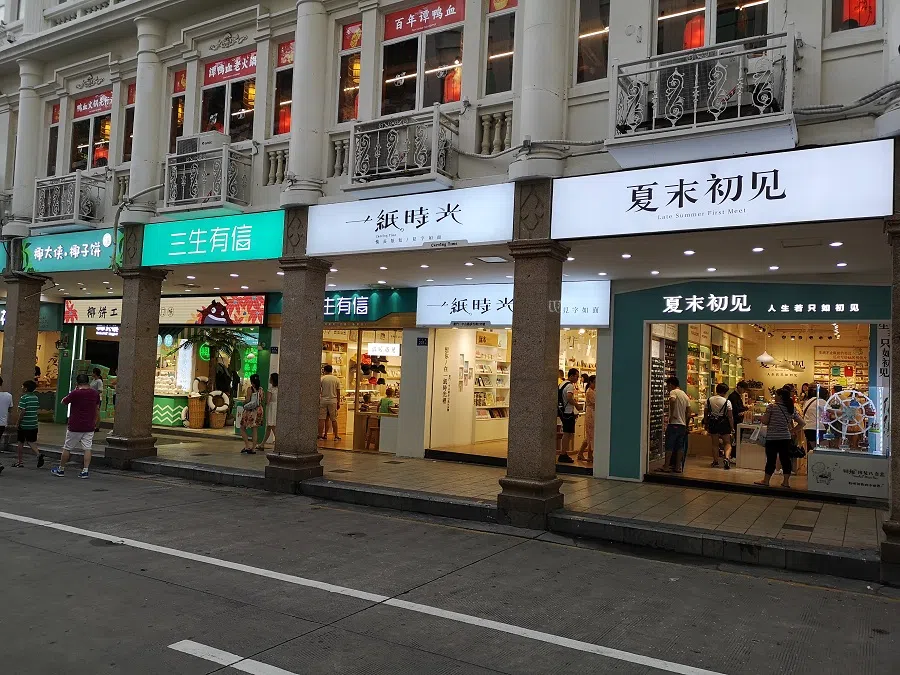
The names alone of these stores are full of artistic flair. Summer’s First Encounter (夏末初见) — with the tagline “If only life were like first meetings” — sells postcards and paper goods. Next door, Paper Moments (一纸时光) — which has the tagline “Thinking of you in the moments captured on paper” — sells letter paper and printed products. The next shop Three Lifetimes of Letters (三生有信, a pun on the Chinese saying 三生有幸, meaning “the luck of three lifetimes”), also focuses on postcards and small crafts. Further down, there is the less poetically named but equally intriguing Coconut Hero (椰大侠), specialising in coconut-based snacks and pastries.
The artistic A Love Letter in Pastry (一封情酥, a pun on 一封情书, meaning a love letter) sells beautifully packaged sweet treats, while a similar shop Three Flavours Pastry House (三味酥屋) sells pineapple cakes and other snacks.

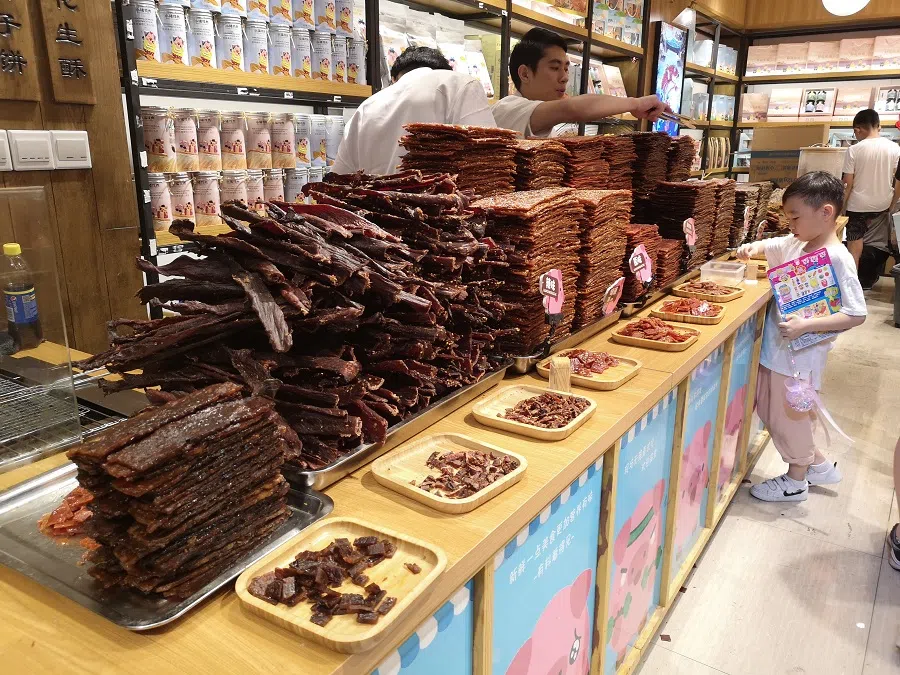
Shops commonly found in tourist districts — tea houses, jerky stores, and pastry shops — have all adopted fresh, innovative looks, with product selections that feel more modern and playful. The charming Little Pig Looking for Meat (小猪找肉) specialises in dried meat and pork products. The clean and simple Sixteen Next Year (明年十六) offers a wide variety of floral teas. The artistic A Love Letter in Pastry (一封情酥, a pun on 一封情书, meaning a love letter) sells beautifully packaged sweet treats, while a similar shop Three Flavours Pastry House (三味酥屋) sells pineapple cakes and other snacks. One of the most unique is An Edible Book (一本可以吃的书), which is branded as a “dessert library” because it packages its pastries in boxes that resemble books.
Xiamen’s old town is a gamut of well-known eateries. You will find an array of foods on offer, from traditional dishes like Huang Zehe Peanut Soup (黄则和花生汤), 1980 Braised Pork Rice Dumplings (1980 烧肉粽), and Lan’s Meat Rice Dumplings (蓝氏肉粽) from Quanzhou, to the trendy internet-famous Zhang Sanfeng Milk Tea shop (张三疯奶茶). Hidden in alleyways, are stalls selling shacha noodles (沙茶面, inspired by Southeast Asia’s satay sauce), popiah (vegetable rolls) in Jukou Street, “four fruit soup” 四果汤 on Zhenbang Road, and bean curd. The smell of food fills the air, regardless of whether you are on main streets, in little alleys, in older shops, or in front of nameless street stalls.

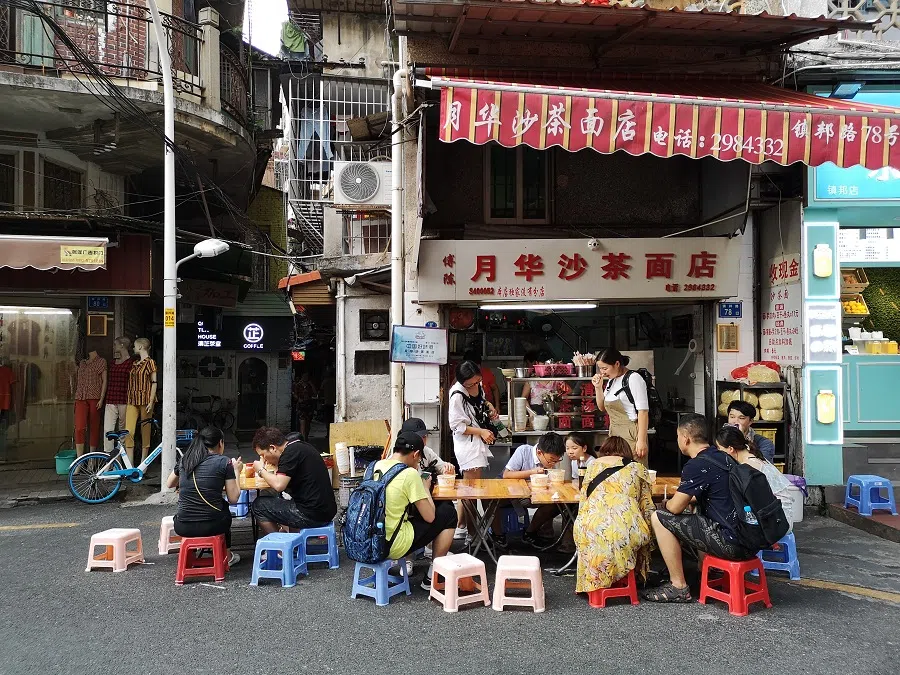
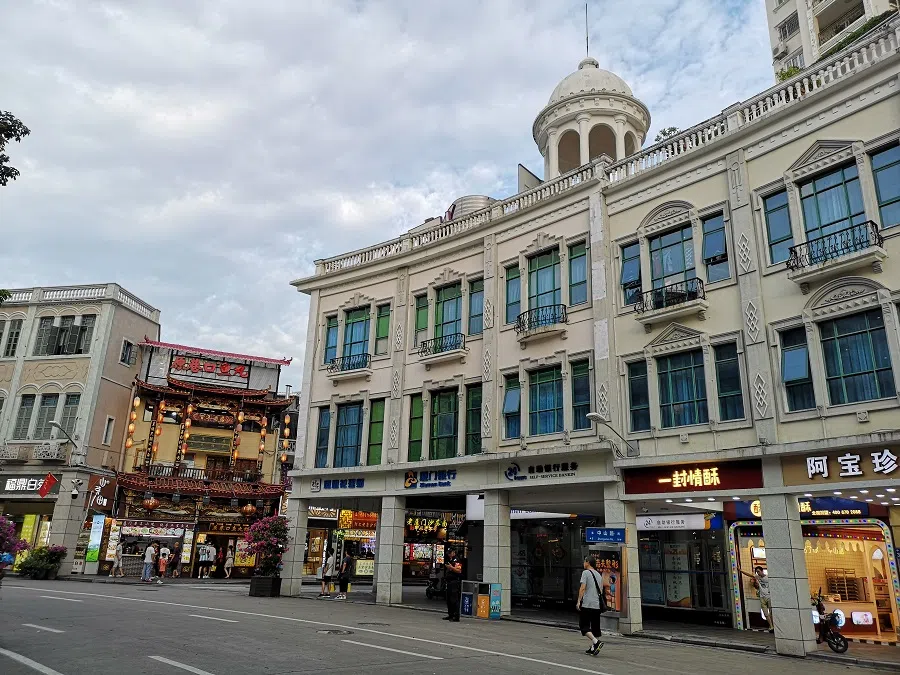

The atmosphere on the pedestrian street is even livelier on weekends. Music drifts through the air, and tents are set up at intervals for various events, such as children’s education fairs, real estate promotions, stage performances — each bringing its own energy. As one event ends in the afternoon, a new one is set up for the evening, keeping the street bustling from dawn to dusk.
At night, Zhongshan Road is different again. The street is brightly lit, and the stores are bustling with people, creating a lively and prosperous atmosphere. The heat of the day gives way to a cooler evening atmosphere, as throngs of tourists and locals happily snap selfies and photos for one another.
This architectural style, common in Southeast Asia and suited to Xiamen’s climate, was introduced to Xiamen in the early 20th century from the Nanyang region. Shophouse-style buildings gained widespread popularity, and became a defining feature of Xiamen’s old town.
Nanyang-style shophouses
Most buildings along Zhongshan Road are shophouses. The first floor or street level abuts on walkways known as “five-foot ways” (五脚基, so called because they are generally about five feet wide). The upper floors are built over the five-foot ways, as if “riding” above them — hence their Chinese name qilou (骑楼, lit. “riding floors/buildings”). This architectural style, common in Southeast Asia and suited to Xiamen’s climate, was introduced to Xiamen in the early 20th century from the Nanyang region. Shophouse-style buildings gained widespread popularity, and became a defining feature of Xiamen’s old town.
As you stroll and look up past the colorful shopfronts to the second floor and above, it feels as if you have been transported through time and space. The unique decorative carvings on the building facades, rows of windows adorned with ornamental grilles, and the balconies and railings jutting out from the walls in a blend of Eastern and Western influences, are all reminiscent of the areas north and south of the Singapore River in old Singapore. Though the shophouses in Zhongshan Road stand in a row, each has its own distinct style, channelling countless stories from the past.

One of the most striking examples is the five-storey shophouse at 67-71 Zhongshan Road, with its prominent rooftop clock tower. This building was once Yong An Tang, where magnate Aw Boon Haw sold his Tiger Balm Ointment and set up Xingguang (星光), the Sunday pictorial supplement of Sin Chew Jit Poh (星洲日报) owned by Aw. It later became the headquarters of Xiamen Daily (厦门日报).
This was once home to Thian Sian Hotel (天仙旅社), one of Xiamen’s oldest hotels, founded by Chinese Singaporean entrepreneur Lu Tien Poh (吕天保).
At 210 Zhongshan Road, the building curves gracefully to match the street corner, with elegant French-style windows, delicate relief carvings, and charming semi-circular balconies protruding from the facade. This was once home to Thian Sian Hotel (天仙旅社), one of Xiamen’s oldest hotels, founded by Chinese Singaporean entrepreneur Lu Tien Poh (吕天保). The writer Yu Dafu once stayed here and even wrote a foreword for the hotel’s special publication, adding to its storied legacy.

While Zhongshan Road is the most bustling and prosperous street in the old town, I personally enjoy wandering along a few of the surrounding streets. Away from the pedestrian street, you can no longer walk in the middle of the road. Nor are the storefronts as flashy. However, it is easier to visualise what the streets here used to look like.
Datong Road also starts at Lujiang Road; it runs parallel to Zhongshan Road and stretches for quite a distance. The street faces the ferry terminal and is adjacent to the customs office and post office. Back in the day, it was also a busy, thriving thoroughfare.
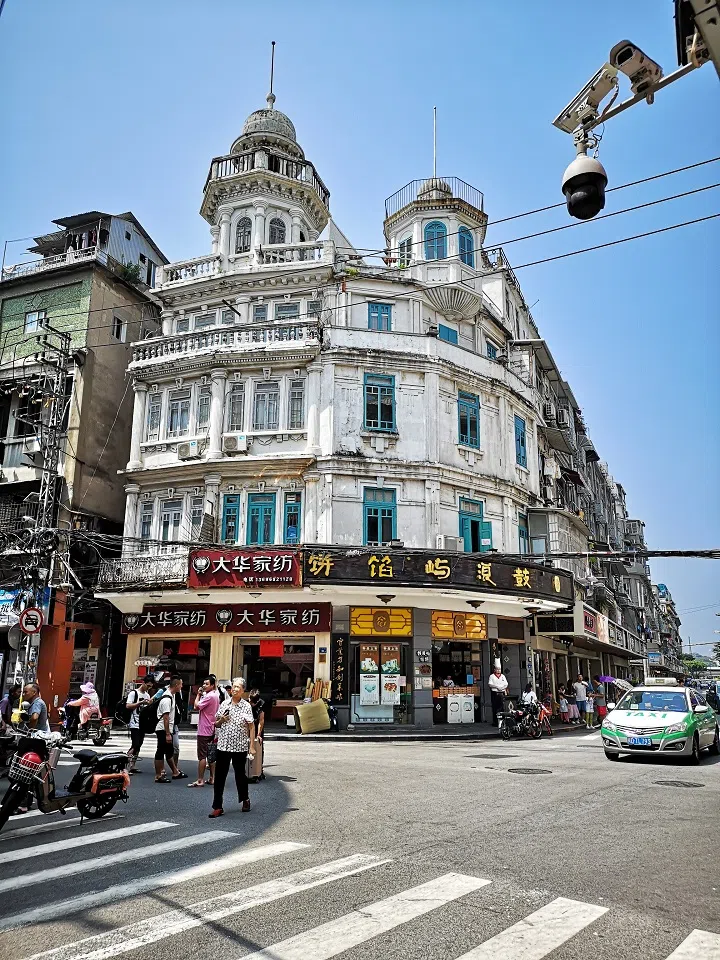
The Chun Guang Hotel at the start of Datong Road retains much of its old-world charm. Formerly known as Daqian Inn, it was the largest of its kind in Xiamen when it was founded in 1932; dignitaries and overseas Chinese used to stay there. As you continue along the road to the intersection with Hengzhu Road, you find yourself surrounded by iconic buildings that housed the era’s most luxurious and fashionable department stores. The most eye-catching building is a five-storey Western-style building topped with twin pagoda towers. It used to be a well-known medical hall, and remains one of the most distinctive old buildings on Datong Road.
A walk through these alleys reveals a myriad of stores, including barbers, foot massage parlors, mahjong halls, automobile shops and shoe repair shops, which provide a snapshot of everyday life in Xiamen.
Alleys: a portrait of local life
Between Datong Road and Zhongshan Road lies a complex web of narrow alleys. Compared to the wide, open roads, these winding, serpentine paths are much more interesting. Though they may seem like dead ends, they often connect to an intricate network of other alleys. Some of these lanes are so narrow that only one or two people can pass through at a time, but they twist and turn into another world.
A walk through these alleys reveals a myriad of stores, including barbers, foot massage parlors, mahjong halls, automobile shops and shoe repair shops, which provide a snapshot of everyday life in Xiamen.
Looking at the road names, the names of the main streets — Datong, Zhongshan, Kaiyuan, Shengping — bear the weight of the city’s development, while the names of the smaller lanes and alleys carry a distinct local flavour, such as Dajingjiao Alley (大井脚 tua che kar, meaning the area around a big well), Anmi Alley (暗迷巷 am ber, meaning porridge), Laicuocheng (赖厝埕 lai chu tia, meaning the open area outside the Lai family home/residence), and Shanziding Alley (山仔顶巷, sua kia teng, meaning the top of a little hill). And these names have to be read in the Minnan dialect, for the most authentic flavour.

In this small area, different architectural styles — Western-style mansions, Nanyang shophouses, old-style Minnan houses — coexist in harmony. The main streets are mostly stately Western buildings for commercial use, but hidden deep in the alleys are residential homes that offer a completely different world to discover.
Once, while wandering around the Dazhong Road area, I caught a glimpse of a red brick building. Out of curiosity, I went further in, and stumbled upon Tianyi Building (天一楼, also known as Qingrang Hall 庆让堂).
The century-old villa looks very different from what it was — it is now derelict and dilapidated — but its structure and scale remain unchanged. With its faded red brick walls, bagua-style (octagonal) pavilion, semi-circular stone-columned porch, and granite base, along with the exquisitely carved door, it is easy to imagine its past grandeur. At the back of the red brick mansion is a hexagonal temple (Weizhen Hall 威震殿) built on a large rock, making it rare and unique.
I ventured into Dazijiu Alley (大字酒巷, lit. big word wine alley, apparently named after a wine shop that used to stand at one end of the alley during the Qing dynasty and was known for hanging a large cloth banner on the storefront with the character “wine” 酒 on it).
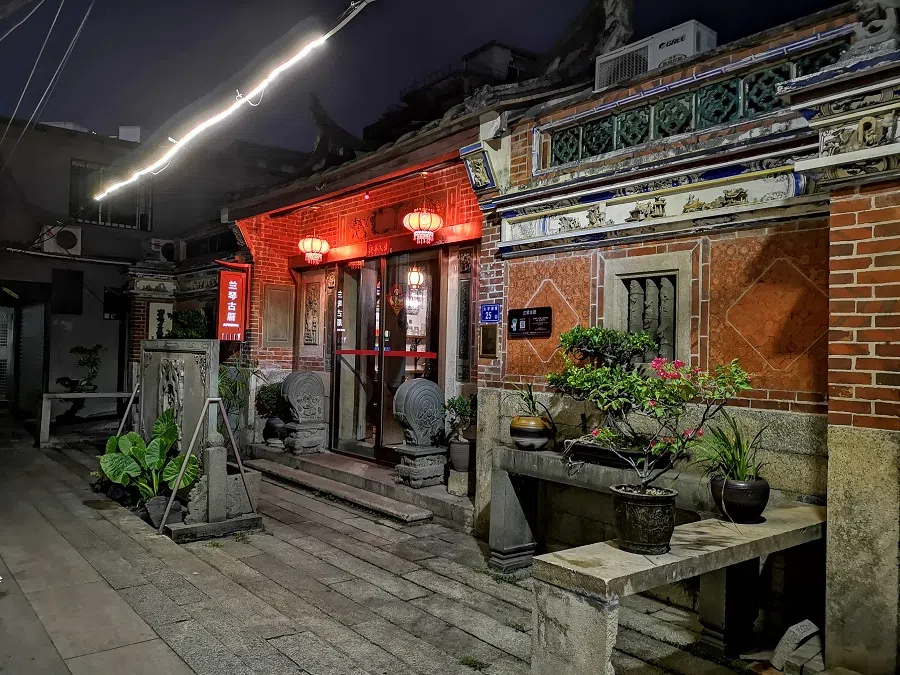
One evening, I cut through the Zheng Chenggong Memorial Square (dedicated to the rebel patriot) on Zhongshan Road and arrived at Dingan Road, which runs parallel to Zhongshan Road. I ventured into Dazijiu Alley (大字酒巷, lit. big word wine alley, apparently named after a wine shop that used to stand at one end of the alley during the Qing dynasty and was known for hanging a large cloth banner on the storefront with the character “wine” 酒 on it).
There, I found Lanqin Mansion (兰琴古厝), one of the most well-preserved old Minnan-style residences in the city. It is now a guesthouse. It was once the residence of Taiwanese anti-Japanese resistance hero Weng Jun-ming 翁俊明, also the maternal grandfather of entertainer Judy Ongg (翁倩玉). As it was late at night and inconvenient to go in, I just paused outside to admire the architectural details — the curved swallowtail eaves and auspicious carvings — while wondering what the night had in store for me.
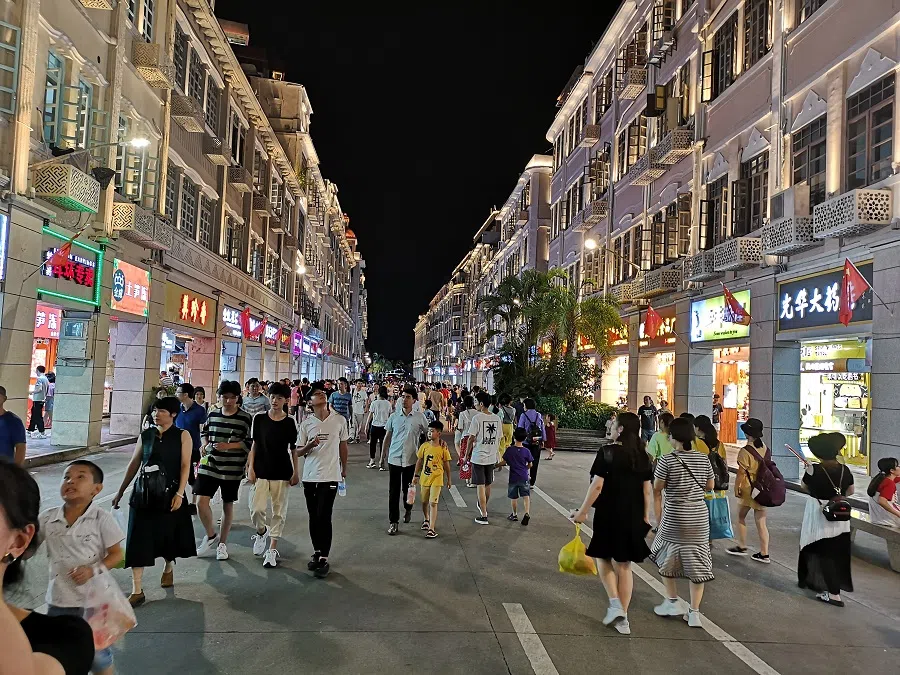
The serene alleys are a stark contrast to the bustling streets nearby. Just a street away is Zhongshan Road, still buzzing with throngs of people. After all, the night is still young.
This article was first published in Lianhe Zaobao as “恋恋老厦门 南洋骑楼风华依旧”.
